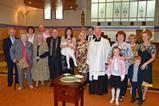Alex Taylor will help you avoid uninspiring Christian fiction and find books that your children can lose themselves in

Fiction can be a remarkably powerful tool to help children engage with faith and grow as followers of Jesus. It enables children and young people to encounter questions of life and faith safely, and explore the responses of the characters in the story, as well as question what their own response might be. But Christian fiction is often ignored in favour of more obvious faith-forming activities.
Now, it’s fair to say that Christian fiction can be a patchy affair. There have been some blockbuster series (about which I found this article interesting), but children’s and young people fiction has floundered a little.
In a previous life, I commissioned children’s and young people’s fiction for a Christian publisher. Many people thought that it was easy to write a Christian children’s story, but they were wrong. Novels that were submitted to me often fell into this pattern:
• We meet a child. They live in a stereotypical Christian family.
• Something happens to the child. This might be anything from losing a favourite toy to being bullied at school.
• The child tells a parent. They pray together. Whatever has happened is resolved.
• They live happily ever after.
There are a few problems with this. One, it’s unrealistic, and so gives the reader an unrealistic picture about what faith is like. Two, it makes grown-ups seem like they know everything and their faith is all sorted, leaving the reader feeling inadequate and that their faith will never be good enough. Three, characters are crudely drawn and don’t have any depth, leading to a fourth problem: it’s very boring.
Instead of building faith, stories like these can end up doing the opposite: they can put children and young people off, because the picture of being in relationship with Jesus depicted in the book bears no relation to their own experience. They can compare their own messy lives with the depiction of faith in stories and think that because theirs doesn’t match the ones they read about, they aren’t doing faith right or being a good Christian. So what makes a good faith story?
Well, the best children’s and young people’s Christian fiction books are as complex and well written as their secular counterparts. They show children and young people with realistic lives. They show Christian adults as flawed, but striving to live their lives and parent their children according to their friendship with Jesus. They show that sometimes things aren’t tied up in a neat bow by the end of the story, and that this is OK.
And the best Christian books allow children and young people to do these things: to see life through another’s eyes, to experience different life events, to understand the feelings of others and to think about what they themselves might do in different situations. And to reflect on how their faith might impact what they would do.
The best children’s and youth work is based on self-discovery: revelations are much more powerful when the child or young person discovers them for themselves rather than when they are told ‘the answer’ by a children’s or youth worker. The same is true of this kind of faith development. The best Christian fiction leaves the reader with questions that they themselves can try to answer and situations that they are compelled to wrestle with.
As parents, carers and children’s or youth workers, this can leave us feeling uncomfortable. We want to protect those in our care and not expose them to situations or feelings that might make them sad (or give them ideas!). We want to make sure we tell our children what they should do. But this does our children and young people a disservice.
Finding the right book
To start with, get recommendations of Christian parents or children’s and youth workers. They may have stories that their children and young people have enjoyed and been challenged by.
Search online for Christian fiction. (Or if you have one of those rarities, a Christian bookshop near you, browse their shelves.) And to make sure you’re getting a good book, read it yourself before you pass it on to your child or young person. Assess the book on some of the criteria discussed in this article – does it challenge, is the way the characters act realistic, does it allow for deeper reflection?
And be careful not to fall into the trap of trying to shield your child from difficult subjects. Fiction is a great way for children to safely explore those difficult subjects, so when they encounter them in real life, they have already thought about what they would do.
Try these to start:
Key Stage 1 (five to eight)
Arlo and the Great Big Cover-Up, Betsy Childs Howard (Crossway)
The Other Kitten and Friska My Friend, Patricia St John (10 Publishing)
Key Stage 2 (eight to eleven)
A Captive in Rome (Tales of Rome), Kathy Lee (SPCK)
The Chronicles of Narnia series, CS Lewis (Harper Collins)
Fire by Night, Hannah MacFarlane (Scripture Union)
Treasures of the Snow and The Tanglewoods’ Secret, Patricia St John (10ofthose)
An Adventure in Presadia series, Luke Aylen (Lion Fiction)
Key Stage 3 (eleven to 14)
No Angel, Kathy Lee (Scripture Union)
Nothing Else Matters and The Victor, Patricia St John (10ofthose)
Beech Bank Girls series, Eleanor Watkins (Dernier Publishing)
Older teens
Phoebe and Lydia, Paula Gooder (John Murray Press)
The Oncoming Storm, Andrew R Guyatt (Scripture Union)
Reading with your child
Reading can be a great solo experience, but when we’re trying to build faith as well as get all those other great benefits of reading, reading with your child can also bring worthwhile rewards. For a start, it means that children can explore books that are slightly older than they are able to read. Now, you may have gone through this article getting frustrated because your child or children are not strong readers and don’t enjoy books. Those who struggle with reading often find that the books they are able to read are too young for them. Yet, if you read to your child, they can explore stories that are age appropriate.
And if you read to your child with a view to growing faith, you’re right there to chat about the story – you can wonder together what a character might do next, what your child might do in a similar situation, whether a choice made by a character was the right one or where Jesus might be in a story. There are so many directions you can go in which will help children see what faith in action might look like. Even if your child reads for themselves, you can still ask them all these questions – particularly if you have already read the book to check it out.
So, not only is reading good for us, we can explore stories that grow, refine and sharpen our faith. The same is true for adults, young people and children, so why not make use of this great faith development tool and introduce children to new ways to meet Jesus and discover what he has done for us?




































